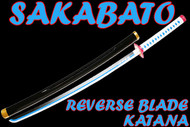Sakabato: Theory of the Reverse Blade Katana
Posted by SwordsSwords on Sep 12th 2023
In the world of edged blades, the sakabato is a rare variant of the iconic Japanese katana sword. This work of art is distinguished by its reversed curved single edge blade.
According to Japanese folklore, this unusual blade configuration was purposefully designed to allow swordsmen to disable opponents in combat without killing them.
While primarily known today through works of fiction, the reverse blade sword's origins and symbolic meaning have roots in traditional Japanese sword culture.
Reverse Blade Katana History
The word “Sakabato” literally means “reversed blade” or “inverted edge blade”.
The earliest mentions of the sakabato come from folktales centered around the Edo period (1603-1868) of feudal Japan. The stories describe swordsmen who adopted a reverse blade katana as a way to practice martial arts without inflicting lethal injuries.
By reversing the sharp side of the blade, disabling strikes could be delivered through blunt force impact rather than slicing cuts. Over time, the sakabato became associated with concepts of non-lethal self-defense and atonement in Japanese sword culture.
Sakabato Symbolic Meaning
The Sakabato reverse blade came to symbolize the idea of combative nonviolence through its distinctive blade design.
In Japanese history, tales of warriors exist who swore off killing and reversed the edge of their katana blade to further reinforced this symbolic meaning. By using a weapon that allowed disabling opponents without drawing blood, the sakabato represented a philosophical commitment to self-defense without lethal force.
This symbolic significance persists in modern works where characters use sakabato as a visual representation of their non-killing ideals.
Sakabato vs Katana
While based on the ubiquitous single-edged katana design, the sakabato differentiated itself through having a blunt rounded edge on the sharp side of the blade rather than a fine cutting edge.
This key trait aligned with its intended purpose of allowing techniques to disable rather than kill.
However, very few authentic historical sakabato have been found from the Edo period compared to the prevalence of samurai sword. This scarcity fuels debate around whether sakabato were truly utilized in combat or remained more of a theoretical weapon design.
Portrayal in Popular Manga and Anime
The sakabato reverse blade sword first gained widespread recognition outside of Japan through its prominent portrayal in the Rurouni Kenshin manga and anime series from the 1990s.
In the story, former assassin Kenshin Himura carries a sakabato sword as a symbol of swearing off killing after the Meiji Restoration.
Through this globally popular work, millions of modern audiences were introduced to the concept and folkloric origins of the sakabato. Its appearance in other fictional stories has further cemented the sakabato in popular culture.
Authentic Surviving Sakabato Examples
While exceedingly rare, a small number of authentic sakabato samurai swords have been found that can be dated back to the Edo period through stylistic analysis. Notable museum collections like the Tokyo National Museum house sakabato in their weaponry exhibits.
Examining these few surviving historical pieces provide clues into how some sakabato were constructed compared to creative design diagrams. However, their scarcity has also fueled debate around their practical usage versus symbolic role in historical martial arts.
Debate Around Real-World Usage
Some people are skeptical about whether sakabato served solely as theoretical weapons or saw true usage on historical battlefields. While Japanese folktales describe techniques employing sakabato katana, the lack of documentation of this traditionally edged blades raises questions.
Some argue sakabato filled a specialized niche rather than being mass produced. Others believe their rarity suggests sakabato were largely symbolic inventions rather than common combat tools.
More archaeological evidence could help solve this ongoing debate around the sword’s practical applications versus cultural significance.
Cultural Impact and Legacy
Through prominent fictional portrayals and intriguing folkloric origins, the sakabato katana maintains a place in Japanese history of samurai swords. It continues to intrigue martial arts and sword aficionados worldwide.
The unusual design concept of allowing non-lethal techniques has endured as a thought-provoking element of traditional Japanese culture. Even as debates surround its historical usage, the sakabato remains a culturally significant weapon symbolizing combative philosophy through reversing the sharp edge of the ubiquitous katana sword.
Have a look at the most iconic blades in anime! You will be surprised at the 3rd one!

